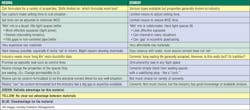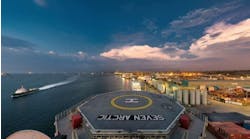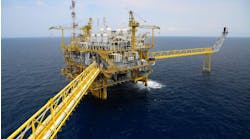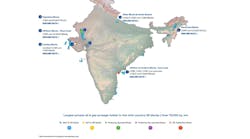New areas identified for further study
Keith Caulfield
Endeavor Management
The subsea industry grew rapidly in the late 1980s and 1990s, developing many of the deepwater products and systems we take for granted today. The times are similar now for the decommissioning industry. In the next few years the decommissioning industry will make similar advancements. Endeavor Management is leading a subsea decommissioning joint industry project (JIP) in an attempt to enhance such growth.
This JIP is the indirect result of an Endeavor Management decommissioning benchmarking study, done in 2014 and 2015 for a group of companies led by Petrobras. The study focused on best practices in subsea decommissioning, with six operators who work in various geographical areas. During that study, Endeavor saw repeated questions on certain decommissioning issues.
During the execution of this JIP, the member companies raised other questions that were added to the list of issues under study, including an emerging regulatory review of certain environmental questions and the use of coiled tubing for open water intervention service.
A selection of the major findings is presented here to demonstrate industry’s current capability and its progress.
Economic vessel model
One of the first goals was to develop an economic decision analysis model for intervention vessels. The model created allows a user to select a combination of abandonment tasks and different vessels to compare costs and risks using:
- Multi-service DP vessel (MSV) working riser-less
- MSV working with a riser system
- Mobile offshore drilling unit (MODU), either DP drillship or DP semisubmersible
- Hybrid cases in which multiple vessels do one job.
The user chooses from: pulling and setting wireline plugs, perforating tubing and casings, setting cement plugs, isolating and testing the A, B, and C annuli, and other tasks to abandon a simple deepwater producer.
The tasks selected are linked to an estimate of the minimum trouble free hours necessary to perform each task. From this, the model creates a default P10, P50, and P90 range for each task.
The base case is the simple abandonment of a single zone subsea producer. The model allows the user to perform a base case abandonment with each of the three vessel types, using either the default times and costs or the user’s times and costs, and for two water depths: 800 m (2,625 ft) and 2,250 m (7,382 ft).
The result of this study provides the member companies with a completely-adjustable decision analysis model that allows the user to make basic vessel decisions under a wide variety of circumstances. It gives ample flexibility to assure that the model fits the user’s goals and assumptions.
Resins vs. cement
Resins enable a step-change improvement in pressure and flow isolation barriers in well construction and abandonment. The single-most important difference between resins and cement is that the liquid phase of resin solutions forms the sealant, while in cement slurries the solids phase forms the sealant.
Resins are able to penetrate places where cement solids, even nano-sized materials, cannot go. This allows installation or creation of more effective barriers within the well system that are not possible with cement.
However, resins cost 20 to 30 times more than typical cement slurries. But, if decommissioning procedures are written to maximize the unique character of resins, dramatic operational savings are possible that will more than offset extra material costs. Combinations of resin and cement plugs are a cost-effective way to install multiple and multi-component barriers for reliable, long-term zonal isolation.
The results of this study gave the answer: “No, resins are more expensive, if they are used as simple substitutes for cements in abandonment.” However, this answer carries a huge, game-changing caveat that is explained in detail within the JIP report.
Cement bond logs
The industry’s ability to obtain information for multiple annuli is severely limited. The ultimate goal is to someday “see” the cement in all annuli by means of a log or similar device. At present, industry can only reliably access one annulus at a time.
The cement bond log (CBL) is a major indicator of annulus condition and provides necessary information before effective decommissioning. At least one major integrated service provider has tested a process that, when back-checked by pulling casing and examining the actual cement job against the logs, can give reliable CBL information across two annuli. This advanced waveform processing carries the possibility of gathering CBL data across as many as four annuli, but the tool and system need much more development.
Another service provider has developed a tool for single annuli use with advancements in the type and quality of information obtainable. This tool can provide CBL data in the presence of gas and various wellbore liquids. The tool also gives reliable data regarding shear and flexural strength of the cement. These two pieces of information can improve assessment of annular cement compared to current data.
Outer annuli and access
Accessing and evaluating outer annuli in existing and future subsea wells is a significant challenge. If conditions, especially pressure, in outer annuli are known at the time of well decommissioning, the decommissioning plans, equipment, and operations can be tailored to known conditions. This would reduce risk and uncertainty, and allow use of lower cost intervention vessels and equipment.
An extensive list of companies with expertise in these areas was compiled, contacted, and interviewed. Several technology areas offer significant potential for future breakthroughs in assessing outer annuli conditions. For existing wells, there is continued development of multi-functional tools that allow perforating and assessment of annuli, followed by circulating or squeezing for isolation.
The results of this study show that the industry is not yet able to “see” through more than one annulus at the time of decommissioning. However, several companies and technologies are tantalizingly close to breakthroughs that could radically change this status.
In situ abandonment
The JIP examined available research on deep-sea benthic (coral reef-related) ecology in water depths of more than 3,000 ft (914.4 m), focusing on ecological responses to decommissioning deep-sea hardware. The goal is to provide regulators, industry, and the science community with ecological guidance, and to aid them in making decisions about removal options (complete, partial, or in situ).
The deep-sea boasts some of the highest levels of biodiversity in the world, but very low population density. It is an exceedingly sensitive environment. The deep seafloor is barren, without many places for sea life to reside. Habitat is at a premium. Normal habitat, such as coral reefs, does not exist at this depth. Where habitat is found, life is diverse but delicate.
The deep seafloor is extremely still and unchanging. Disturbances there, such as a mud cloud from removing mud mats, can last for decades. Mud disturbances can kill much of the diverse life here, especially filter-feeders.
Leaving properly-cleaned (internally) subsea equipment such as pipelines, PLETs, PLEMs, SUTAs, and similar equipment on the seafloor “in situ” provides extra habitat (substrate) for reef-like animals, allows other deep-sea marine life to accumulate around these reef-like organisms, and eliminates damage caused by man-made disturbances.
The JIP documented the fact that leaving hardware on the seafloor has significant ecological benefits over the long term (decades and longer). The hardware would create in situ deep-sea habitat, increase colonization and species connectivity, and sustain deep-sea biodiversity. The JIP also made several recommendations regarding surveying of biological connectivity, habitats, sediments, and structures.
Further study
During the execution of the JIP, a number of areas were identified for further study. These include:
Decom vessels.A consistent factor in discussing deepwater decommissioning has been the regulatory requirements governing the vessels used to intervene in offshore wells. Emerging in the vessel industry is a trend in which any vessel taking well returns - such as those that can be experienced during well intervention or abandonment - must be classed as a MODU for safety purposes. This works against the industry vision of doing meaningful intervention work from the “back of the proverbial boat.” Some work could be done on this subject to clarify matters.
Resins. One major unknown in the industry, awakening to the use of resins for decommissioning, is the lack of scientific data regarding the longevity and durability of resins. A major accomplishment to advance the industry knowledge would be to define, proscribe, and provide a solid estimate for systematic testing of resin durability. With basic technical documents and test procedures in place, and a trustworthy estimate of the costs required, the industry could make more effective decisions with such testing. Another area that could aid the implementation of resins is for resin experts to define a simple operational guide that would help field personnel choose the right resin for the majority of oilfield applications. Such a guide would help estimate the equivalent amount of resin that would effectively replace cements in several situations. It would also illustrate placement techniques to allow significant operational cost savings vs. cements.
Pipelines. Pipeline blockage location was one of the highest recurring suggestions in the study on pipeline flushing. An examination to assess possible advancements in blockage detection would focus industry attention toward a step change in this costly area.
In situ abandonment.Much study can be done to further the science behind deepwater marine life. The industry can help support this issue by performing ROV surveys along seafloor installations at every opportunity to assess the state of marine life and the results of seafloor disturbances, when these occur. More than this, the industry must collaborate and share this data to create an open dialogue with regulators.
Conclusion
This subsea decommissioning JIP has identified present industry capabilities and approaches to guide new research and tool/process development to overcome decommissioning challenges. It also revealed additional areas of study around specific tools and improved processes. As the industry recovers and expands decommissioning efforts, these new study areas can guide future JIPs to continually improve decommissioning safety, technology, and economics.
The author
Keith Caulfield, P.E., Operations Advisor and JIP Project Manager, has extensive experience in both the upstream and downstream oilfield arenas. This includes design experience in offshore and deepsea structures, pressure vessels, and oilfield mechanical engineering, such as subsea wellheads and subsea trees. He is named on four US patents or patents pending and has management experience in offshore field development, environmental processing, drilling tools, subsea equipment refurbishment, and subsea well intervention.






